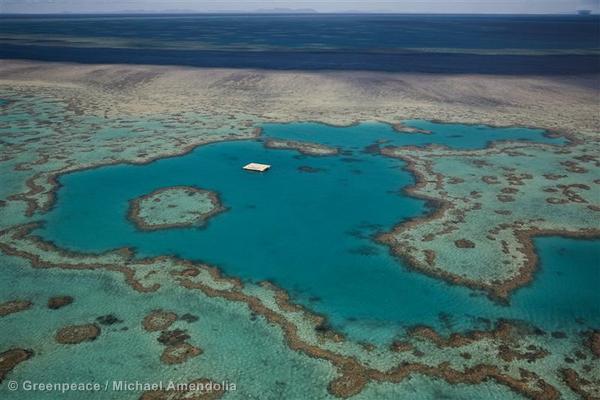Right now the Australian government is deciding the fate of Australia’s Coral Sea. The countdown is on to protect nearly one million square kilometres of unique coral reefs, atolls and underwater canyons flanking the world-heritage listed Great Barrier Reef.
Blogpost by Nathaniel Pelle – December 6, 2011
Just a few weeks back I sailed out of Port Moresby aboard the Greenpeace ship Esperanza, through the Coral Sea and then north into the Western and Central Pacific Ocean. These are the very same waters my Grandfather patrolled as a youth in the Australian Navy during the historic Battle of the Coral Sea in the latter half of World War II.
I remember fondly his striking stories that described swimming alongside warships among remarkable abundances of marine life. His memories recalled sailors at play with swarms of dolphins, turtles, swordfish and large schools of gentle hammerhead sharks. I remember his tales of catching tuna at will with simple handlines dropped lazily from the poopdeck.
Sadly, such abundance is a rare thing to see these days. So it is with a tremendous sense of hope that I have observed the considerable efforts of regional players to preserve these waters and maybe even return them to their past richness.
The latest of these opportunities is the proposal by the Australian government to create the world’s largest marine park in the Coral Sea under a once-in-a-generation bioregional planning process.
But it’s not all good news: the government’s draft plan leaves the majority of species-rich coral reefs, important breeding sites for tuna and marlin, and critical migration routes for turtles and whales open to fishing. More than 20 important reefs – identified as key biodiversity hotspots – remain outside the no-take zone and are open to potentially damaging activity. Leaving these areas unprotected is a shortsighted move to appease a handful of vocal commercial and recreational fishers. Left unprotected are the crucial spawning grounds for bigeye and yellowfin tuna; this year both species were listed as vulnerable and near-threatened on the IUCN’s red list of species at risk of extinction.
For this proposal to achieve its potential -as much as possible of this area needs to be fully protected – you can add your voice to the call for a genuinely historic sanctuary here.
Australia has stood by regional efforts to protect these species. With Australia’s support, Pacific Island nations have banded together to close 4.5million square kilometres of the high seas to purse seine fishing in order to safeguard their recovery.
Earlier this year, Palau – a nation that thrives on its stunning and incomparable marine ecosystem– declared its entire territorial waters a shark sanctuary and has created a network of marine national parks. The Esperanza is now in Palau assisting with enforcement of their territory. Swimming in these waters, so dense with life, I feel like I’ve had a taste of what the Pacific was like when my grandfather sailed it. That’s what I want for the Coral Sea.
The Marshall Islands followed Palau’s lead and look set to be joined by Fiji and the Cook Islands. With every one of these moves the benefit is multiplied across the region.
It’s fantastic that the Coral Sea proposal blocks oil exploration and mining for good and reduces some destructive fishing. But if Australia is to cement itself as a genuine champion of marine protection, and create a sanctuary that provides long-lasting regional benefit, it needs to greatly expand the area of the Coral Sea afforded full protection.
Nathaniel Pelle is Oceans Campaigner for Greenpeace Australia Pacific


